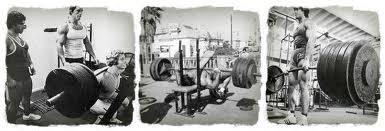Are ab muscles the same as core muscles?
Abs and Core
 The core has become a fitness buzzword. People seem to think core training is synonymous with abdominal training, which explains why various websites, blogs, trainers and television home shopping commercials, use that phrase to attract misinformed readers desperate for a six-pack. In truth, the core is much more than a six-pack, and it needs to be treated as such.
The core has become a fitness buzzword. People seem to think core training is synonymous with abdominal training, which explains why various websites, blogs, trainers and television home shopping commercials, use that phrase to attract misinformed readers desperate for a six-pack. In truth, the core is much more than a six-pack, and it needs to be treated as such.
It's time to destroy misconceptions about core training and restore its true meaning. Endless sets of sit-ups and leg raises will only take your core so far. Eventually, your core will need to support heavy weight under serious stress when you squat, deadlift, or press. Kick the crunches aside and learn heavy lessons that build insane core strength!
Just because a strong healthy body with a six-pack, a tiny waist and a strong core is important for so many people, the fitness enthusiasts, the bodybuilders, the fighters (MMA, wrestlers, boxers, kick-boxers) but also the general population, especially the young generation that wants to look good with their shirt off and on the beach. There are so much different approaches to reach this goal. Kettle bells, Medicine balls, jump ropes, slam balls and suspension kits are only a few of the instruments used to train the core muscles. And many gadgets to train the abs more about that later in this article.
Core Principles
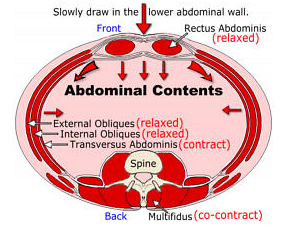 The core is a collection of muscles which stabilize and move the spine. Close to the spine and deep inside the abdomen is the inner core, which is comprised of the diaphragm, pelvic floor, multifidi, deep cervical flexors, and transverse abdominus. These strange-sounding muscles engage first during movement or breathing to protect the spine.
The core is a collection of muscles which stabilize and move the spine. Close to the spine and deep inside the abdomen is the inner core, which is comprised of the diaphragm, pelvic floor, multifidi, deep cervical flexors, and transverse abdominus. These strange-sounding muscles engage first during movement or breathing to protect the spine.
The outer core muscles are also responsible for stabilizing and protecting the spine, but they also have more defined movement functions. The anterior muscles (abdominals) are the most well-known members of the outer-core assembly. The lats, spinal erectors, glute complex, quadratus lumborum, and hip flexors are also outer-core muscles.
If you want to get academic, you could make an argument that the core extends far beyond these muscles localized to the spine and hip complex. But for our current scope, the muscles I just mentioned nicely define the core.
Simplified Core Strength
"The core stabilizes and protects the spine by creating stiffness that limits excessive movement in any direction."
Purposeful core action requires understanding its function. The core stabilizes and protects the spine by creating stiffness that limits excessive movement in any direction—most notably extension, flexion, lateral flexion, and rotation. In lifting terms, the core's responsibility is to limit movement.
Think about the core through the scope of strength exercises like the squat, deadlift, bench press, and overhead press. These movements require the spine to hold a rigid position so the hip and shoulder joints can move with force. The core muscles create the rigid spine position.
To make the core stronger, you only need to let it do its job and protect the spine when you put heavy loads in your hands or on your shoulders.
From this perspective, every exercise is a core exercise. Complete an exercise with good form and you trained the core to do its job. Consistently increase the load of an exercise using good form and you make the core stronger.
Important core muscle groups
In this section, I give you the rundown on the most important parts of your core/ab muscles and how you should train them.
Rectus abdominus – the six pack muscle
When you look at someone’s washboard abs — also known as the six pack — you’re seeing his rectus abdominis muscle.
When this muscle group contracts, it flexes your lower (lumbar) spine. Basically, it moves your ribcage closer to your pelvis.
But even when you’re not moving, it can function to harden your abdomen and increase your intra-abdominal pressure which stabilizes and strengthens the spine during exercise.
Contrary to popular thought, this is not really a series of six (or more) muscles. Instead, it is a pair of muscles stretching from the ribcage down to the front of the pelvis on either side of the body’s centerline.
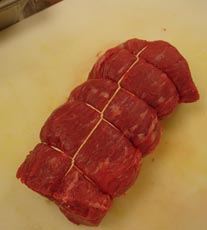 Just as a butcher uses twine to keep a roast from losing its shape, connective tissue keeps your rectus abdominis properly positioned in your body
Just as a butcher uses twine to keep a roast from losing its shape, connective tissue keeps your rectus abdominis properly positioned in your body
The reason your sixpack appears to be a group of muscles is because it’s restricted by several bands of collagen connective tissue (similar to tendons). Along with a fibrous sheath which surrounds the muscles, these bands of connective tissue hold the muscle in place.
Think of the connective tissue like a belt holding your coat in place. Without the belt, your coat would flop around; and without these bands, your muscle wouldn’t be able to move your body effectively. (To learn more, read Tendinous intersection at Wikipedia.)
External core muscles on a model with low body fat levels.
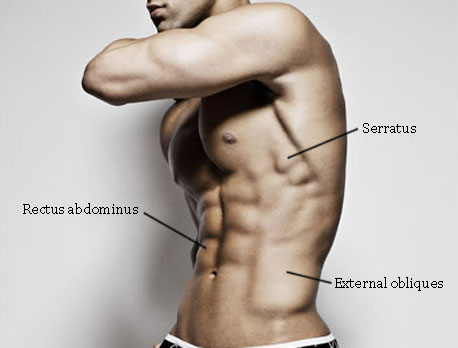 Obliques The external and internal obliques have many different functions, but for our purposes here, we’ll simply note that they flex your lumbar spine laterally; they also assist in rotation. As with most core muscles, they contract to harden the abdomen and support the spine during exercise. The obliques connect the side of your ribs to the outer part of your pelvis.
Obliques The external and internal obliques have many different functions, but for our purposes here, we’ll simply note that they flex your lumbar spine laterally; they also assist in rotation. As with most core muscles, they contract to harden the abdomen and support the spine during exercise. The obliques connect the side of your ribs to the outer part of your pelvis.
Interestingly, the internal obliques help you breathe. They work in opposition to the diaphragm (the muscle which inflates your lungs). When you get a stich in your side during heavy aerobic exercise, you’re experiencing a cramp of your internal oblique muscle.
In modern times, training the obliques has fallen out of favor. This is because bodybuilders don’t like to train a muscle that makes their waist appear thicker. They want that V-shaped taper from their wide shoulders to their narrow wasp-waist. Large obliques spoil this aesthetic.
But athletes need strong oblique muscles, and they train the obliques with just as much care as they give to the rest of the core musculature. So, don’t neglect your obliques just because bodybuilders ignore them. Make sure to strengthen your entire core so you don’t develop any weak spots.
Transversus abdominis Picture: Frank Zane makes his waist smaller with a vacuum
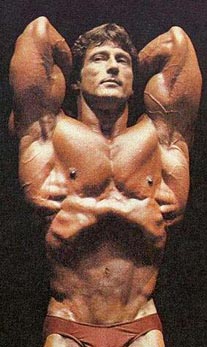 The transversus abdominis (I’ll call it the transverse abs) is a relatively small muscle that pulls your internal abdominal organs “upward” when you hollow out your stomach area during a “vacuum” exercise.
The transversus abdominis (I’ll call it the transverse abs) is a relatively small muscle that pulls your internal abdominal organs “upward” when you hollow out your stomach area during a “vacuum” exercise.
During the height of the bodybuilding movement, bodybuilders thought it was important to suck in the abs to make the waist appear smaller. They called this “pulling a vacuum”.
Because of the huge, drug-induced bellies on most of today’s world-class bodybuilders, this technique is no longer widely used. You might still see it in drug-free competitions where the participants are much smaller because they’re not supplementing with human growth hormone.
The transverse abs are controversial. There are lots of unsubstantiated claims about the benefits of direct training the transverse abs. Much of it seems to be hogwash, in my opinion. One thing’s clear: no pro athlete spends time trying to isolate and train his transversus abdominis muscles. If having total control over your midsection is important to you, feel free to train these muscles. But don’t do it just because someone tells you it’ll help you in a mystical, hard to explain way.
Lower back muscles – Erector spinae
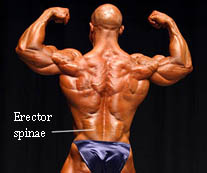 Erector spinae muscles on a bodybuilder.
Erector spinae muscles on a bodybuilder.
Yes, the lower back is part of your core, and if you neglect it during training, you’ll pay a price.
The lower back muscles you need to think about are your erector spinae. They’re the muscles just above your buttocks, on either side of your spine.
The erector spinae straighten the waist (along with your hamstrings). When you arch your lower back, you can feel your erector spinae working.
Give your lower back the chance to grow and strengthen along with your front core muscles. Don’t just work out your six-pack muscles and totally neglect your lower back. Remember: balance your core muscles or you set yourself up for an injury.
Lower back training with heavy weights is for advanced lifters. Since it takes longer for the lower back muscles (especially the internal ones that are not under your conscious control) to recover from a max-effort workout, you have to be careful to avoid overreaching and over-use injuries in this area. There is little need to use massive weight to directly train the lower back until you get a decent amount of experience in weight lifting.
of weight lifting belts how your spine is supported by your abdomen and core muscles.)
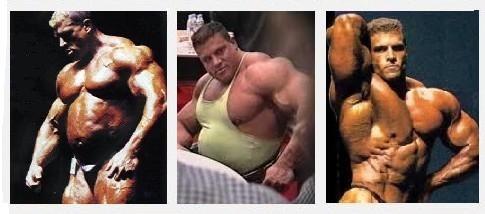
Greg Kovacs : I was a silly bastard back in the day. I had the audacity to use my bloat for stability; you've probably done it before too. In my estimation, lifting heavy and not focusing on pulling in my abdominal muscles contributed greatly to my distention. I would think that it plays a factor with many bodybuilders. I performed some heavy lifts regularly with no regard to keeping my abdominal wall tight, rather I let it out. It wasn't as stylish as it is now to pay attention to your core muscles. There were no BOSU balls or heavy emphasis on core training, we didn't think about it. I never gave any thought to strengthening my core along with the rest of my body. I was flat out old school – ab training was for women and right before a contest. Unfortunately, I was wrong. This is one of the main reasons for herniated belly buttons. Iron freaks don't want to waste time training abs, we want to lift heavy but it comes at a price. As we build all that muscle and neglect our transverse and supportive muscles in the abdominal girdle, something will give out. And, when it does, it is those muscles that cause the herniated belly button. I have one still, but since I have been incorporating core work, I am finding that it is flattening out dramatically.
Franco and Sylvester
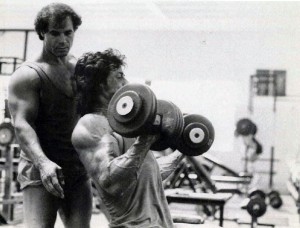 Sly’s first radical transformation came when he transformed his body for Rocky III. During training for this movie, he trained with bodybuilding legend Franco Columbo. Audiences were surprised at the bronzed, lean physique which hit the big screen.
Sly’s first radical transformation came when he transformed his body for Rocky III. During training for this movie, he trained with bodybuilding legend Franco Columbo. Audiences were surprised at the bronzed, lean physique which hit the big screen.
“Man, back in those days, I would literally do everything and anything to burn more fat and get as lean as possible. I would go for long morning cardio sessions consisting of jogging or swimming, do about 18 rounds of sparring in the ring for Rocky and then hit the gym for 2 hours, too. And this is all while I was starring and directing the movie. Yeah, I didn’t sleep too much!”
That’s because Sly was on a mission to achieve the best physique on the big screen. His only problem? The massive Arnold Schwarzenegger. While action stars of today can rustle themselves into fairly decent  shape without needing to be concerned about competing against a six-time Mr.Olympia champion, Sly did not have that luxury and knew that if he was going to be able to stand out he needed to work his ass off.
shape without needing to be concerned about competing against a six-time Mr.Olympia champion, Sly did not have that luxury and knew that if he was going to be able to stand out he needed to work his ass off.
He began training alongside bodybuilding legend Franco Columbo in California as he attempted to achieve his best physique in the third installment of his Rocky franchise.
“I drew up a plan to help Sylvester and he achieved some fantastic results from our short time together. You can see those results in the movie,” recalls Columbo. “He is an achiever. He never sits back and waits for things to happen – he’s the one out there making them happen!”
In true ’80s spirit of the film “Rocky-IV” had a training montage with an awesome soundtrack.Rocky trained in a barn up in the snowy Russian mountains, really hardcore in other words. Those exercises was one that got most people to get anxiety just by the thought of implementing it. In one of the standout training scenes, Stallone mounted an old school table in a barn and performed an exercise which caused men everywhere to hit the gym. He was doing leg lifts with his butt off the table. (where he was holding on to the table and his shoulders and head were the only thing touching the table, this exercise is called “Dragon Flags” . In the same scene Stallone performed another hard core exercise “hanging crunches” on the top level of the barn. A favorite from Franco (see picture).
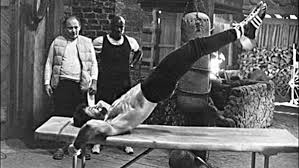
A healthy posture
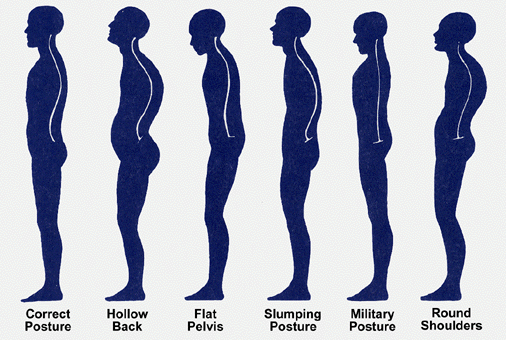 A properly aligned healthy posture provides the following benefits:
A properly aligned healthy posture provides the following benefits:
•Improves your appearance
•Reduces the occurrence of tension headaches
•Decreases back pain and shoulder discomfort
•Reduces the risk of spinal injuries
•Will make you appear taller and thinner
•You will look confident
Factors contributing to poor posture include:
•Obesity
•Pregnancy
•High heel shoes
•Tight or weak muscles
•Poor sitting or standing habits
•Ectomorphs tend to be lightly muscled/ weak making them prone to poor posture
In order to achieve great posture you need to be conscious of how you are holding your body and support your body to maintain this posture with core work, strength-training exercises and stretching
Better Breathing
I'd like to leave you with a final tip on breathing. You may not think how you breathe has an impact on your core, but it makes a big difference. Most people "shoulder breathe" by elevating their shoulders and lifting their rib cages to let air in. This is erroneous because the diaphragm can't do its job effectively. It also limits the function of the inner core—the muscles affected most powerfully by breath.
Be cognizant of your breathing and breathe air into the lowest point of your belly. Breathe this way when lifting, walking, sitting, reading, and talking. Seriously, it's important!
A quick fix
Do those gadgets really give you flat abs or a six-pack stomach?
When commericals for those gadgets that claim to trim and strengthen the abdomen come on, out-of-shape viewers can't help but feel a jolt of guilt about their expanding waistline and, perhaps, their long-running absence from the gym. But then comes the sweet promise that they can slim down, without breaking a sweat.
"Just 10 minutes with Fast-Abs is equivalent of up to 600 sit-ups," the commercial announcer says, as images of buff bodies are shown on screen. "Now you can work out your abs anywhere watching TV, at the office, even around the house."
From coast to coast, the airwaves are bloated with gadgets like the "Ab-Energizer," "Fast Abs" and "The AbTronic" that promise to shape up your abdominal muscles, even without exercise. The marketers claim that ab gadget devotees will find themselves with bodies like Superman or Wonder Woman, but critics say it isn't so.
- Login to post comments



